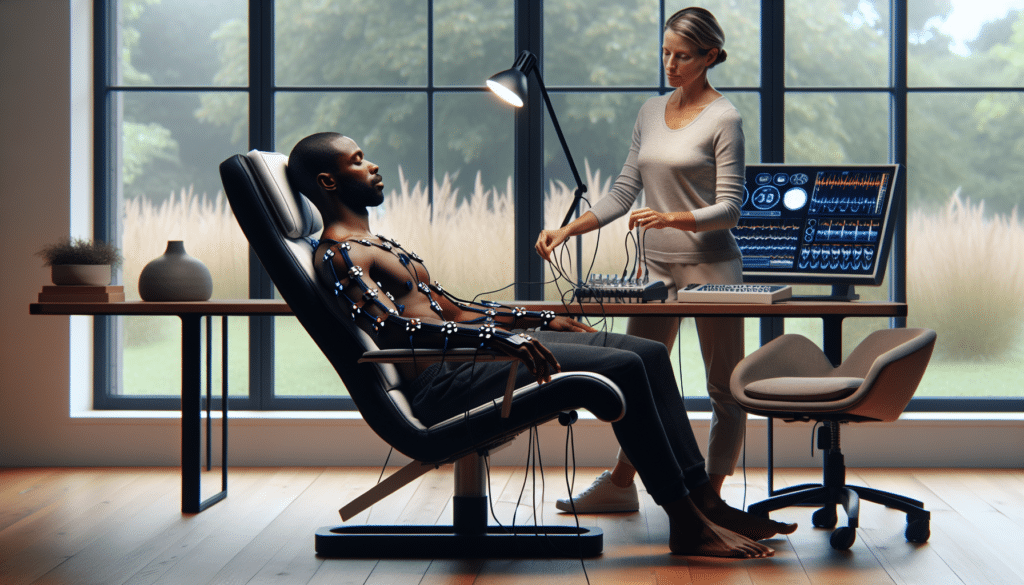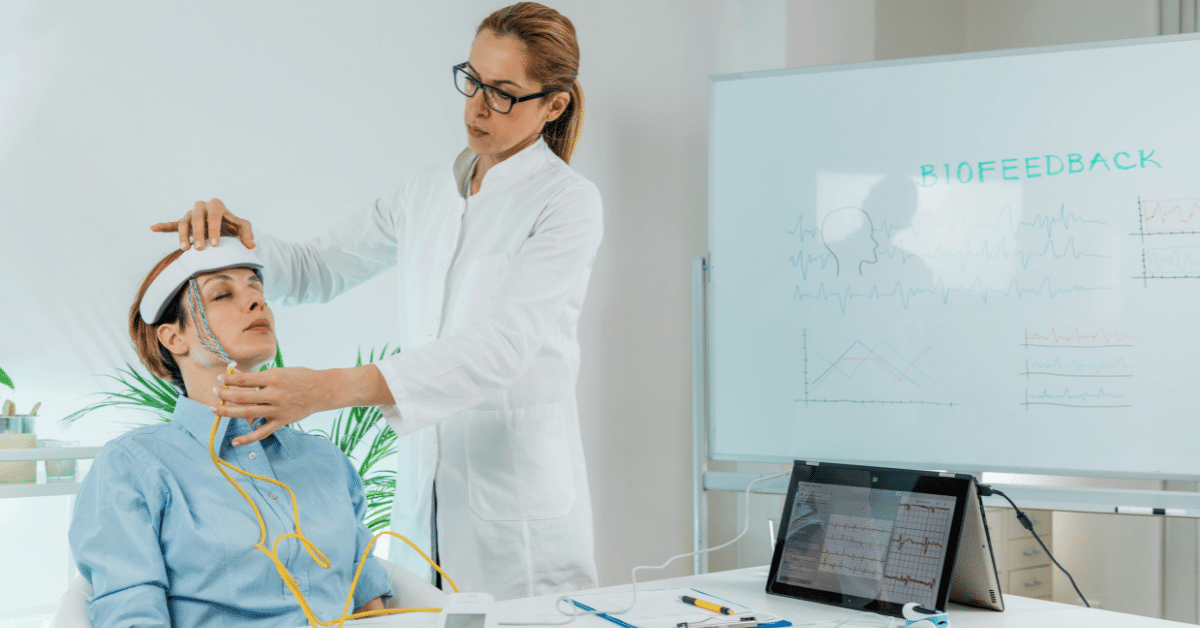Biofeedback therapy is gaining attention for its ability to help people control body functions like heart rate and stress 1. This blog will cover how it works, its benefits, and everyday uses to help you manage your health better.
What is biofeedback therapy, and how does it work?
Biofeedback therapy involves using electronic monitoring devices to train individuals to control bodily processes, like heart rate and muscle tension, that are normally involuntary. This therapy helps manage stress, pain, and other conditions by teaching techniques to control physiological reactions through real-time feedback.
This blog is part of a series on “relaxation techniques.” The next blog is about autogenic training.
Key Aspects of Biofeedback Therapy
- Definition: Biofeedback therapy uses monitoring devices to teach control over involuntary bodily functions.
- Techniques: It includes methods like heart rate and brain wave monitoring for stress and pain management.
- Benefits: Offers improved management of anxiety, chronic pain, and other stress-related conditions.
- Applications: Widely used in both clinical and home settings to enhance physical and mental health.
- Learning: Patients learn to modify their physiological activity through real-time feedback, gaining better health control.
- Safety: A non-invasive and safe method with high patient involvement and control.
What is Biofeedback Therapy?
Biofeedback therapy allows you to manage involuntary bodily functions such as heart rate and muscle tension. It’s a non-invasive method where sensors track how your body reacts to different conditions. This therapy helps you recognize stress and anxiety triggers, allowing you to react using relaxation techniques.
It has become popular in alternative medicine for its role in managing chronic pain and stress without medication. Patients can improve their mental and physical health by learning to control these functions. Biofeedback sessions typically involve real-time data feedback that aids in teaching relaxation and control.
Types of Biofeedback and Their Specific Functions
Biofeedback varies by the type of sensor used and the bodily function it monitors. The most common types include EEG biofeedback, which monitors brain waves and is often employed in treating ADHD and other brain-related conditions. Heart rate variability biofeedback helps manage heart rate and is useful in stress and anxiety management.
Another type, EMG biofeedback, focuses on muscle activity and is useful in treating conditions related to muscle tension and movement disorders. Meanwhile, thermal biofeedback measures skin temperature, which can indicate stress levels and help reduce them.
| Type of Biofeedback | Monitored Function | Common Uses |
|---|---|---|
| EEG Biofeedback (Neurofeedback) | Brain Waves | ADHD, Sleep Disorders, Stress Reduction |
| Heart Rate Variability Biofeedback | Heart Rate | Anxiety, Stress Management, Heart Conditions |
| EMG Biofeedback | Muscle Activity | Muscle Rehabilitation, Chronic Pain, Sports Training |
| Thermal Biofeedback | Skin Temperature | Stress Reduction, Migraine Prevention |
| Respiratory Biofeedback | Breathing Patterns | Asthma, Anxiety, Breathing Disorders |
Each biofeedback type targets specific health issues, offering tailored therapy options. This specialization helps ensure the right technique is used for the right condition, maximizing therapy effectiveness.
How Biofeedback Training Works
In a biofeedback session, therapists attach sensors to your body to measure responses like heart rate, breathing, and skin temperature. This session can illuminate how your body responds to stress or relaxation cues. It’s like having a conversation with your body’s subtle signals.
The therapist guides you through exercises that help control these responses. For instance, breathing techniques might be used to calm down or reduce heart rate. As you see real-time feedback, it becomes easier to understand and manipulate your body’s responses.

This training is crucial for patients to learn effective management strategies for their symptoms, whether it’s anxiety, chronic pain, or even muscle tension. These techniques can become second nature with practice, allowing for better health management.
Efficacy of Biofeedback in Treating Health Issues
Studies have shown that biofeedback can effectively reduce symptoms of various conditions. For chronic pain, this therapy can lessen pain intensity and frequency. It also effectively reduces anxiety and stress by helping individuals learn relaxation techniques.
Biofeedback has also been used to treat high blood pressure and headaches, providing a non-drug approach to managing these conditions. The feedback mechanisms help patients understand and control their physiological responses to stressors.
The success of biofeedback depends on consistent practice and application of the techniques learned during sessions. Many find that regular use of biofeedback can improve overall health and reduce the need for medications.
Biofeedback Uses in Everyday Health Management
Biofeedback is not just for clinical settings; it can be incorporated into daily life. People use biofeedback techniques at home to manage day-to-day stress and anxiety. Simple devices can be used to practice these techniques, enhancing relaxation and overall health.
Regular biofeedback practice can also aid in improving sleep quality and managing digestive disorders. It teaches you to control responses such as muscle tension or heart rate, which can be particularly useful before stressful events or in managing chronic conditions.
This therapy fits well into a holistic health approach, complementing other health practices like exercise and meditation. Biofeedback helps regulate body responses, greatly enhancing one’s ability to maintain balance and health.
Personal Thoughts
Exploring biofeedback therapy has been transformative for managing my stress. By monitoring physiological signals, I’ve learned how to relax effectively and see real-time results that reinforce my progress.
This method has given me a practical tool to control my stress response, helping me apply scientific techniques to my everyday life. The difference is palpable, and I recommend trying biofeedback for anyone struggling with similar issues.
Frequently Asked Questions
What conditions does biofeedback therapy treat?
Biofeedback therapy is used to treat a variety of health problems, including stress, anxiety, chronic pain, hypertension, and migraine headaches, offering an alternative therapy method to traditional treatments.
How does biofeedback equipment work?
Biofeedback equipment uses sensors attached to the body to measure physiological activity such as heart rate, muscle tension, and brain waves. This data is fed back to the patient in real time, allowing them to learn how to make subtle changes to their body’s responses and effectively manage symptoms.
What are the benefits of undergoing biofeedback therapy?
Biofeedback therapy offers multiple benefits, including improved control over involuntary physiological processes, pain relief, reduced stress, and enhanced relaxation. Regular sessions can lead to better mental and physical health by teaching techniques that manage body responses related to stress and anxiety.
Is biofeedback therapy considered safe?
Yes, biofeedback is generally safe. It is a non-invasive treatment with minimal risks. Biofeedback is often recommended for individuals seeking nonpharmaceutical methods to manage their health issues. However, conducting sessions with a qualified biofeedback practitioner is important to ensure safety and effectiveness.
Can biofeedback therapy be used as a standalone treatment?
Biofeedback therapy can be an effective standalone treatment for certain conditions, such as stress reduction and muscle retraining. However, it is often used in conjunction with other treatments, including medication and physical therapy, to maximize health benefits and manage more complex health issues.




